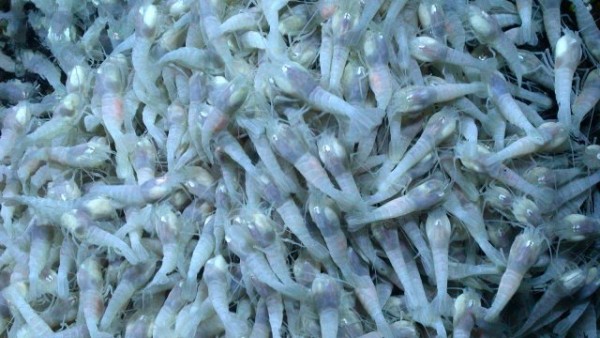Extreme Shrimps Could Possibly be Sent to Populate Europa, NASA Reports
| Marco Foronda | | Nov 23, 2014 08:44 PM EST |
(Photo : Chris German, WHOI/NSF, NASA/ROV) Extreme shrimps thrive near hot vents in the Caribbean Sea.
NASA Jet Propulsion Laboratory (JPL) scientists are currently examining an enigmatic ecosystem, including tiny shrimps in the Caribbean Sea, believing it holds clues about the kinds of life that can thrive in hostile environments on other planets like as Jupiter's icy moon, Europa.
Like Us on Facebook
The shrimps called "Rimicaris hybisae" live in clumps on the edges of hydrothermal vents 7,500 feet underwater whose temperatures reach 750 degrees Fahrenheit. It's also very, very dark down there.
The small shrimps are piled on top of each other, layer upon layer, in cooler water near the vents. They crawl on rock chimneys that eject scalding water.
"You go along the ocean bottom and there's nothing, effectively. And then suddenly we get these hydrothermal vents and a massive ecosystem. It's just literally teeming with life," says Max Coleman, JPL senior research scientist.
A special kind of bacteria, which live inside the shrimps' mouths, allows the shrimps to endure extreme environments because of chemosynthesis, a process that produces energy in the absence of sunlight. Chemosynthesis also involves organisms that obtain energy from chemical reactions.
The bacteria produce organic matter the shrimps feed on. It utilizes hydrogen sulfide, a chemical abundant at the vents, to make organic matter.
Although the shrimps are blind, they have thermal receptors at the backs of their heads.
Scientists believe that if these bacteria can survive in extreme conditions on the Earth, they can also endure similarly harsh other environments of other planets such as Jupiter.
"For two-thirds of the Earth's history, life has existed only as microbial life. On Europa, the best chance for life would be microbial," Coleman added.
"Whether an animal like this could exist on Europa heavily depends on the actual amount of energy that's released there, through hydrothermal vents," said Emma Versteegh, a postdoctoral fellow at JPL.
European Space Agency (ESA) intends to launch its "JUpiter ICy moons Explorer mission" (JUICE) in 2030 to take the first thickness measurements of Europa's icy crust.
NASA also has started preparing a "Europa Clipper mission" that will study the icy moon while doing flybys of Jupiter.
TagsAlien life, Extreme Shrimps Possibly Hold Evidence About Alien Life, extreme shrimp, NASA, ESA, Jupiter's icy moon Europa, Europa Moon, Alien life, Alien, Caribbean Sea, bacteria, Europa Clipper mission, JUpiter ICy moons Explorer mission, JUICE mission
©2015 Chinatopix All rights reserved. Do not reproduce without permission
EDITOR'S PICKS
-

Did the Trump administration just announce plans for a trade war with ‘hostile’ China and Russia?
-

US Senate passes Taiwan travel bill slammed by China
-

As Yan Sihong’s family grieves, here are other Chinese students who went missing abroad. Some have never been found
-

Beijing blasts Western critics who ‘smear China’ with the term sharp power
-

China Envoy Seeks to Defuse Tensions With U.S. as a Trade War Brews
-

Singapore's Deputy PM Provides Bitcoin Vote of Confidence Amid China's Blanket Bans
-

China warns investors over risks in overseas virtual currency trading
-

Chinese government most trustworthy: survey
-

Kashima Antlers On Course For Back-To-Back Titles
MOST POPULAR
LATEST NEWS
Zhou Yongkang: China's Former Security Chief Sentenced to Life in Prison

China's former Chief of the Ministry of Public Security, Zhou Yongkang, has been given a life sentence after he was found guilty of abusing his office, bribery and deliberately ... Full Article
TRENDING STORY

China Pork Prices Expected to Stabilize As The Supplies Recover

Elephone P9000 Smartphone is now on Sale on Amazon India

There's a Big Chance Cliffhangers Won't Still Be Resolved When Grey's Anatomy Season 13 Returns

Supreme Court Ruled on Samsung vs Apple Dispute for Patent Infringement

Microsoft Surface Pro 5 Rumors and Release Date: What is the Latest?











